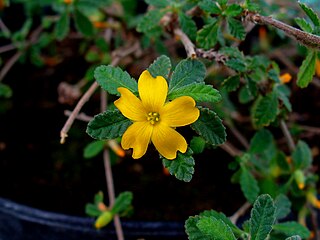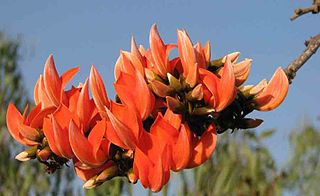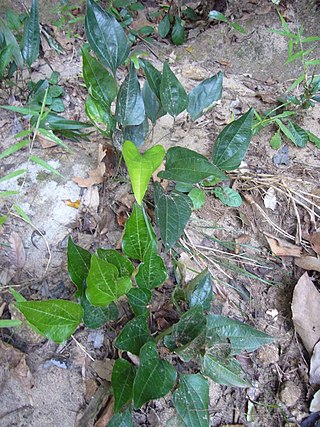An aphrodisiac is a substance alleged to increase libido, sexual desire, sexual attraction, sexual pleasure, or sexual behavior. These substances range from a variety of plants, spices and foods to synthetic chemicals. Natural aphrodisiacs like cannabis or cocaine are classified into plant-based and non-plant-based substances. Synthetic aphrodisiacs include MDMA and methamphetamine. Aphrodisiacs can be classified by their type of effects. Aphrodisiacs that contain hallucinogenic properties like bufotenin have psychological effects on a person that can increase sexual desire and sexual pleasure. Aphrodisiacs that have smooth muscle relaxing properties like yohimbine have physiological effects on a person that can affect hormone levels and increase blood flow.

A progestogen, also referred to as a progestagen, gestagen, or gestogen, is a type of medication which produces effects similar to those of the natural female sex hormone progesterone in the body. A progestin is a synthetic progestogen. Progestogens are used most commonly in hormonal birth control and menopausal hormone therapy. They can also be used in the treatment of gynecological conditions, to support fertility and pregnancy, to lower sex hormone levels for various purposes, and for other indications. Progestogens are used alone or in combination with estrogens. They are available in a wide variety of formulations and for use by many different routes of administration. Examples of progestogens include natural or bioidentical progesterone as well as progestins such as medroxyprogesterone acetate and norethisterone.

Flavonoids are a class of polyphenolic secondary metabolites found in plants, and thus commonly consumed in the diets of humans.

Turnera diffusa, known as damiana, is a shrub native to southern Texas in the United States, Central America, Mexico, South America, and the Caribbean. It belongs to the family Passifloraceae.

Quercetin is a plant flavonol from the flavonoid group of polyphenols. It is found in many fruits, vegetables, leaves, seeds, and grains; capers, red onions, and kale are common foods containing appreciable amounts of it. It has a bitter flavor and is used as an ingredient in dietary supplements, beverages, and foods.

Cyclanthera pedata, known as caigua, is a herbaceous vine grown for its edible fruit, which is predominantly used as a vegetable. It is known from cultivation only, and its use goes back many centuries as evidenced by ancient phytomorphic ceramics from Peru depicting the fruits.

Naringenin is a flavorless, colorless flavanone, a type of flavonoid. It is the predominant flavanone in grapefruit, and is found in a variety of fruits and herbs.

Rutin is the glycoside combining the flavonol quercetin and the disaccharide rutinose. It is a flavonoid glycoside found in a wide variety of plants, including citrus.

Butea is a genus of flowering plants belonging to the pea family, Fabaceae. It includes five species native to the Indian Subcontinent, Indochina, Tibet, and southern China. It is sometimes considered to have only two species, B. monosperma and B. superba, or is expanded to include four or five.

Genistein (C15H10O5) is a naturally occurring compound that structurally belongs to a class of compounds known as isoflavones. It is described as an angiogenesis inhibitor and a phytoestrogen.

Dydrogesterone, sold under the brand name Duphaston among others, is a progestin medication which is used for a variety of indications, including threatened or recurrent miscarriage during pregnancy, dysfunctional bleeding, infertility due to luteal insufficiency, dysmenorrhea, endometriosis, secondary amenorrhea, irregular cycles, premenstrual syndrome, and as a component of menopausal hormone therapy. It is taken by mouth.

Trichopus zeylanicus is a small herbaceous plant, which is one of only two species of its genus, Trichopus. Formerly it was placed in its own family, Trichopodaceae, but is now included in the family Dioscoreaceae. The leaves are about 20 centimetres (7.9 in) long and grow from a rhizome. The shape of the leaves can be highly variable even within one location, but the most common shape is cordate. The herb grows on sandy soil near rivers and streams in shady places in lowland and intermediate altitude forests. It flowers year long and the fruits are thought to be dispersed by water. The unusual flowers are purplish black.

Icariin is a chemical compound classified as a prenylated flavonol glycoside, a type of flavonoid. It is the 8-prenyl derivative of kaempferol 3,7-O-diglucoside. The compound has been isolated from several species of plant belonging to the genus Epimedium which are commonly known as horny goat weed, Yin Yang Huo, and Herba epimedii. Extracts from these plants are reputed to produce aphrodisiac effects, and are used in traditional Chinese medicine to enhance erectile function. However, clinical trial data are lacking to support these claims.
A xanthine oxidase inhibitor is any substance that inhibits the activity of xanthine oxidase, an enzyme involved in purine metabolism. In humans, inhibition of xanthine oxidase reduces the production of uric acid, and several medications that inhibit xanthine oxidase are indicated for treatment of hyperuricemia and related medical conditions including gout. Xanthine oxidase inhibitors are being investigated for management of reperfusion injury.

Fisetin (7,3′,4′-flavon-3-ol) is a plant flavonol from the flavonoid group of polyphenols. It can be found in many plants, where it serves as a yellow/ochre colouring agent. It is also found in many fruits and vegetables, such as strawberries, apples, persimmons, onions and cucumbers. Its chemical formula was first described by Austrian chemist Josef Herzig in 1891.

Taxifolin (5,7,3',4'-flavan-on-ol), also known as dihydroquercetin, belongs to the subclass flavanonols in the flavonoids, which in turn is a class of polyphenols. It is extracted from plants such as Siberian larch and milk thistle.

Miquelianin is a flavonol glucuronide, a type of phenolic compound present in wine, in species of St John's wort, like Hypericum hirsutum, in Nelumbo nucifera or in green beans.

Eriocitrin is a flavanone-7-O-glycoside between the flavanone eriodictyol and the disaccharide rutinose. It is commonly found in lemons and other citrus fruits. It is colloquially called lemon flavonoid or a citrus flavonoid, one of the plant pigments that bring color to fruit and flowers. This antioxidant also predominates in Peppermint infusions.

Melitidin is a flavanone glycoside. Melitidin was discovered in bergamot orange juice and exhibits statin-like properties so the juice seems to have hypolipidemic activity.

Geniposide, the glycoside form of genipin, is a bioactive iridoid glycoside that is found in a wide variety of medicinal herbs, such as Gardenia jasminoides (fruits) . Geniposide shows several pharmacological effects including neuroprotective, antidiabetic, hepatoprotective, anti-inflammatory, analgesic, antidepressant-like, cardioprotective, antioxidant, immune-regulatory, antithrombotic and antitumoral activity. These pharmacology benefits arise through the modulating action of geniposide on several proteins and genes that are associated with inflammatory and oxidative stress processes.



















